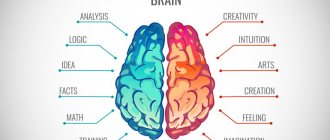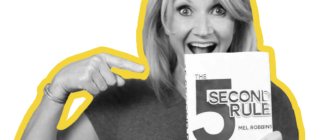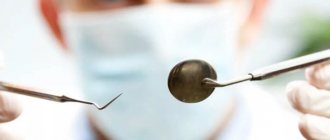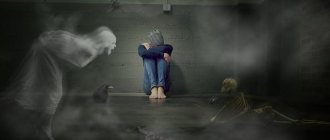People who actively use the right hemisphere of their brain are more likely to be successful, says John O'Keeffe, the author of the method of unconventional thinking. We have already told you what the right and left hemispheres of the brain are responsible for and how they cooperate with each other. Today we’re talking about ways to turn on the right hemisphere at full capacity.
Using the right hemisphere of the brain is relatively easy. These methods are literally on the surface - sometimes you just need to remember them. However, the habits formed in Western society push us only towards logic, analysis and facts. So those who want to succeed should learn techniques that allow the right hemisphere to automatically engage in active work.
Only the left hemisphere - and the whole brain: test
How can you feel the difference between the work of the whole brain and the work of just the left hemisphere? Try to quickly answer the following questions.
SECTION "A"
- Name the seventh letter of the alphabet.
- How many days are there in November?
- Count the numbers from 26 to 0.
SECTION "B"
- Write down instructions on how to get from your home to work by car.
- Write down instructions for tying a tie or shoelace.
- Name all the letters of the alphabet in reverse order.
When solving problems from section “A”, you use exclusively the left hemisphere of your brain. They require predominantly mechanical thinking - mental repetition of words, letters or numbers.
The tasks in section “B” are completely different. They engage the right hemisphere and require that you form a certain picture in your head, and then the left hemisphere translates this picture into logical instructions.
You can easily count the numbers from 26 to 0 - partly due to mechanical thinking, and partly due to logic. To do this, it is enough to use one left hemisphere. However, most people cannot recite all the letters of the alphabet in reverse order because the alphabet has been learned mechanically and there is no logic to it. A different approach is needed here.
There are several simple techniques that allow you to engage not only the left, but also the right hemisphere of the brain:
- Use color.
- Use pictures.
- Use metaphors and analogies.
- Use emotions.
- Use your intuition.
- Use not only facts, but also a coherent story.
- Use not only professional vocabulary, but also figurative expressions.
Gymnastics (charging) for the neurobic brain
What is neurobics - brain gymnastics. It helps synthesize new connections between neurons in the brain and preserves good memory for a long time. It is useful for people at any age: schoolchildren and the elderly for mental correction.
Every person who cares about the state of his own intelligence can learn the simplest neurobics techniques and not be afraid of the onset of senile insanity.
Finger gymnastics
Brain training can begin with finger exercises. Stretch your fingers, bring your palms together, bend your fingers, passing the index finger of your right hand first. Now straighten your fingers and bend them in a different order, lowering the index finger of your left hand first. Repeat these movements several times.
Bend your fingers, straighten them, clench your fists, unclench them. Repeat 10 times. Place your fingers in a lock and rotate both hands clockwise and back, 10 times.
Touch your fingertips to both hands, palms straight. The palms are separated by 5 centimeters. Using springy movements, try to bring your palms together. Repeat 10 times.
Touch the thumb of each hand to the little finger, ring finger, middle finger, and index finger. Repeat everything in reverse order 8-10 times.
Kinesiological exercises
An excellent exercise for the brain is kinesiological exercises. An example would be a simple exercise that is easy to get confused about.
Sitting on a chair, raise your left arm up and raise your right leg 5 centimeters above the floor. After this, clap your palms and raise your right arm and left leg up. Clap both hands and switch hands and feet. Repeat several times.
Squeeze the fingertips of the thumb and little finger on both hands at the same time. Massage the pads, rub one against the other. Now repeat the massage with the ring finger, middle finger, index finger and repeat everything in reverse order.
Place the palm of your right hand on your stomach and your left hand on the top of your head. Make several movements at the same time: rotate the palm of your right hand over your stomach, clockwise. Lightly pat the top of your head with the palm of your left hand. After this, switch hands and repeat the movements. Rotation on the stomach and patting on the top of the head.
Fingers
Fingering exercises for brain development. They are performed simultaneously with both hands, develop synchronous work of the two hemispheres, improve memory, increase reactions, and decision making. New neural connections are formed in the gray matter of the brain.
Exercise plays a big role even in martial arts. Photos of them can be found on the Internet if you ask Google what Fingers are. They are similar to ancient mudras and beautiful poses of the hands of oriental dancers.
Qigong
A special system of Buddhist breathing and movement exercises is called Qigong. It represents a special set of movements with the arms and legs and is associated with the religious teachings of Taoist monks.
Adults and elderly people who practice Qigong gymnastics feel much younger and better than their peers. How to develop your brain 100 percent? Qigong teachers will undoubtedly be able to answer this question.
Yoga
In Indian culture, the concept of Yoga means a combination of spiritual and physical exercises. They are developed in different directions of Buddhism and Hinduism. Yoga develops in a person the ability to control his physical and mental functions. There is Raja Yoga, Karma Yoga, Hatha Yoga and other directions.
The ultimate goal of yoga is to improve a person's physiological abilities and even achieve enlightenment and eternal life. In any case, long-lived yogis are known, with flexible bodies and excellent memory.
Entire books are devoted to other aspects of yoga. Followers of this teaching devote their entire lives to their improvement. The neuropsychological capabilities of such people are very highly developed.
By doing any type of mental gymnastics, a person is able to preserve his memory and intellect for a long time.
From the editor: Massage techniques for getting rid of insomnia
Use color
This method is simple but effective. The next time you write something down, use colored pens or different colors of paper, including very bright ones. Use different colors for headings, highlighted words, summaries, and key phrases. You will feel your mood lift from work. It will become more pleasant, interesting, memorable and fun.
This is how you engage the right hemisphere of your brain. Now several other thoughts come to your mind. You feel that you are no longer constrained by any boundaries. You feel that your thinking is becoming unconventional.
After two or three weeks, try going back to black and white notes. You will find them boring, tedious, routine and limited.
Color is present in almost all business communications - modern technologies allow this. Presentations include color slides. Photocopies may be in color. Personal computers provide color graphics. Newspapers and television have long switched to color. Imagine the opposite situation. Go back to black and white newspapers, movies, television, black and white presentation slides, monochrome monitors. You will feel like you are in a dark basement. This occurs due to deactivation of the right hemisphere of the brain. You will have to expend enormous amounts of energy to use it when faced with an ocean of colorless communication.
If this is so obvious, why continue the habit of using one color when writing, which dates back to the era of quill pens?
Rehabilitation
The implementation of the rehabilitation program begins after the patient’s condition improves. In the rehabilitation clinic, patients interact with speech therapists who offer exercises to gradually restore written and spoken language skills. Physiotherapeutic procedures and massages are carried out by professional rehabilitation therapists. Exercise therapy instructors at the Yusupov Hospital restore motor function through therapeutic exercises, physical education and kinesitherapy.
Stroke rehabilitation programs may include the following:
- magnetic therapy;
- laser therapy;
- acupuncture;
- kinesio taping;
- Voita therapy;
- massage sessions;
- treatment by position and movement.
The rehabilitation clinic of the Yusupov Hospital has modern technical equipment, which, combined with the knowledge of specialists, ensures effective restoration of functions after an ischemic stroke on the right side of the brain.
Use pictures
Pictures are just as effective as color.
One picture is worth a thousand words. Don't limit yourself to a world made up of columns of numbers or pages and pages of facts. Television has triumphed over radio. Personal computers have powerful graphics capabilities and are capable of bringing any information to life. A presentation with only text on the slides will never be as effective as one that uses high-quality visuals. The effectiveness of pictures is due to the fact that they appeal to the right hemisphere of the brain. Pictures can be very simple, approximate; reduced simply to symbols. However, the question “How can this be illustrated?” includes the right hemisphere of the brain. The combination of color and pictures is even more effective.
Diagnostics
When a patient with signs of a stroke comes to the Yusupov Hospital, specialists strive to accurately determine the state of blood flow in the brain vessels of the right hemisphere. The first priority in complex diagnostics are visualization methods: CT and MRI, which make it possible to establish the localization of the lesion, the type and subtype of stroke, and also determine which vessel pathology led to disruption of brain nutrition.
With ischemic stroke, a “mismatch” phenomenon occurs, which can be detected during perfusion CT. A feature of this condition is that with a decrease in blood volume and the speed of its movement, an ischemic penumbra zone appears. This area of the brain contains cells whose death can be prevented.
Comprehensive diagnosis of ischemic stroke of the right hemisphere at the Yusupov Hospital is carried out using high-precision methods:
- cerebral angiography is prescribed to patients if surgical intervention is necessary;
- transcranial Doppler sonography is carried out to study the state of blood flow in the brain;
- electroencephalography is used to establish areas of subcortical and cortical damage;
- Positron emission tomography and scintigraphy are performed to assess the nature of brain metabolism.
Use metaphors and analogies
Metaphors and analogies stimulate the right hemisphere—both yours and those around you. They evoke emotion and a sense of belonging, and help paint a picture much better than dispassionate detailed descriptions. For example, when faced with a problem of duplication of responsibilities, a typical response is to investigate and analyze the problem. Another approach that involves the right hemisphere of the brain would look like this. In your speech, you resort to the proverb “Seven nannies have a child without an eye,” and then propose to clearly delineate areas of responsibility.
By comparing a goal or problem to something distant from the area being discussed, metaphors and analogies remove the limitations of standard thinking. When you say phrases like “Let's try to become like Microsoft” or “Let's catch up and overtake Coca-Cola in popularity,” it pushes the boundaries of conventional thinking and removes barriers to creative thinking.
Causes of development of cerebrovascular accidents
The cause of the development of right-sided ischemic stroke is the cessation of blood supply to the hemisphere. This condition occurs due to blocking of the lumen of the vessel by an atherosclerotic plaque, embolus or thrombus. The area of damage directly depends on the size of the lumen of the blood vessel.
Ischemic stroke of the right hemisphere is a studied disease. The main reasons for its development are:
- the age of the patient, the risk of developing the disease is higher in older people;
- gender - up to 80 years of age, the likelihood of ischemic stroke is higher in men, but after this age the opposite trend is observed;
- chronic stress, increased anxiety;
- burdened heredity, this reason is confirmed by numerous studies devoted to the issues of vascular accidents in people whose family members have suffered a stroke.
Doctors identify causes that can be corrected in order to prevent ischemic stroke:
- high blood pressure;
- irrational lifestyle and use of toxic substances, overeating;
- increased body weight;
- taking combined oral contraceptives;
- atherosclerotic vascular lesions.
Primary prevention of ischemic stroke is aimed at correcting lifestyle, increasing human activity, and reducing body weight.
Use emotions
There is nothing wrong with emotions. They exist, and at the same time they can have an impact much stronger than logical constructions. The combination of emotions and logic can sweep away all obstacles in its path. Television advertising becomes much more effective when it appeals not only to logic, but also to emotions. For example, one of the commercials dedicated to car tires especially emphasizes their role in ensuring safety. The advertisement uses an image of a huge tire with a child sitting in it - this is a combination of logic and emotion.
Reports and presentations sound much more convincing if they appeal to the feelings of the audience, and not just to logic. This has to go in: use your own emotions to appeal to other people's emotions.
Prevention
In order not to fall into the risk group, it is necessary to lead a healthy lifestyle and undergo examinations. Avoid eating foods that increase cholesterol and sugar levels.
Prevention measures:
- Avoid smoking tobacco and drinking alcohol - this is required if dangerous symptoms appear or an alarming clinical picture is detected.
- Reduce the level of emotional tension, avoid stress and sudden outbursts.
- Physical activity - overload and grueling training without proper recovery are unacceptable.
- Continuous blood pressure monitoring.
- A healthy diet - without unhealthy foods high in fat, the right balance, getting rid of excess weight. This is true for men who have reached middle age - a risk group.
If diseases are identified that can provoke an ischemic or hemorrhagic stroke, you must immediately undergo a course of treatment.
Use your intuition
We are too often interested in facts and do not ask about premonitions. Facts are pure logic. In contrast, intuition is associated with the right, creative, hemisphere of the brain. The combination of logic and intuition has enormous power.
Apparently, a person makes the most important decisions in his life with the participation of both hemispheres of the brain, and not just the left. We can name three such moments: the choice of a spouse, profession and place of residence. These decisions may have to be made several times in your life. However, none of them are usually accepted based on logic, analysis, and facts alone.
The issue of starting a family is not a dispassionate decision based on hard facts and logic. The choice of profession is largely based on feelings, a few signals, as well as impressions and inclinations, but not on rational analysis. The house you live in is also chosen based on feelings, not dry facts - you often act illogically, overpaying to live in a place you like.
Treatment
A patient who has suffered a stroke requires emergency care and hospitalization. Numerous studies of this disease confirm that treatment carried out in the first three days is most effective, since the activity of nerve cells surrounding the lesion is high.
Neurologists at the Yusupov Hospital begin treating the consequences of a stroke after a comprehensive examination of the patient. The treatment and rehabilitation programs developed by our specialists are based on the principle of the individuality of each patient, however, if the blood supply to the brain is impaired, the following measures are mandatory:
- monitoring of cardiac activity and blood pressure;
- prevention of early contractures, pneumonia;
- ensuring the required level of blood oxygen saturation and removing excess carbon dioxide;
- maintaining homeostasis - equilibrium of the internal environment;
- monitoring the condition of the intestines and bladder;
- swallowing control;
- skin care and prevention of bedsores.
Treatment of patients after pneumonia involves the use of drugs and non-drug methods. To take into account contraindications, cardiologists, neurosurgeons and resuscitators take part in drawing up the treatment program.
Drug therapy after a stroke involves the use of the following drugs:
- antihypertensive drugs for high blood pressure;
- osmotic diuretics and dexazone are used for cerebral edema, as well as to prevent increased intracranial pressure;
- anticoagulants, which include heparin, help control blood clotting;
- antiplatelet agents (trental, beta blockers, calcium antagonists) are used to identify signs of insufficient blood supply;
- drugs with a neuroprotective effect are used to restore neurons.
The Yusupov Hospital creates comfortable conditions for every patient. After a stroke, patients need professional care, which is provided by the staff of the neurology clinic:
- introducing fluids and nutrients into the body;
- turning the patient from one side to the other every 2 hours;
- performing cleansing enemas once every two days;
- wiping the skin every 8 hours with camphor alcohol;
- cleaning the nasopharynx and oropharynx using suction and then rinsing them.
Use not only facts, but also a coherent story
"The facts speak for themselves." It is not true. Such statements are often made by people who fail to fully convince their interlocutor.
If the facts really spoke for themselves, then all controversy would cease. Everyone would come to the same obvious conclusions. The very fact that you use the expression “the facts speak for themselves” indicates the opposite: you were not able to fully convince the audience, the job is only half done. You must be prepared to use a variety of stories and anecdotes to evaluate the facts presented—to bring them to life so that they make sense to the listener. For example, one story or one anecdote can be more effective than a whole list of facts - and they are remembered better.
Symptoms of a right-sided stroke
A stroke on the right side is a disaster, because the centers responsible for sensitivity, coordination, motor skills, and muscle tone suffer. The person loses motor abilities. The right-sided centers function as regulators of the activity of all left-sided organs and limbs. Therefore, a right-sided stroke and its consequences affect the mobility of the left arm, leg, eye, and ear.
Main functions of the hemisphere:
- speech understanding;
- spatial perception;
- touch;
- intuition;
- hearing, speech;
- writing, reading;
- mathematical abilities.
The dangerous consequences of a stroke on the right side can be minimized if the symptoms of the disaster are recognized in time and immediately seek medical help.
Signs of the disease:
- Loss of sensation in left limbs.
- Facial muscles are affected - sagging of the lower lip, left eyelids, abnormal smile, inability to fully open the mouth, tongue shift.
- Vision and hearing lose their sharpness and clarity.
- Damage to the right hemisphere during a stroke is accompanied by the appearance of mental reactions - lethargy, apathy, aggression, loss of emotionality.
- The patient cannot estimate the actual size of objects.
- Memory loss.
- A sharp increase in blood pressure is a sign of a right-sided stroke.
- Vomiting, severe nausea, dizziness.
- Tingling, numbness, goosebumps.
- Paralysis.
- Loss of coordination, balance, orientation.
- Signals from the autonomic system - heavy sweating, shortness of breath, palpitations, redness of the face.
- Loss of ability to concentrate.
Headache is an alarming symptom of a right hemisphere stroke. It is sharp, intense, cannot be relieved by conventional antispasmodics, and brings the patient to loss of consciousness.
Use not only professional vocabulary, but also figurative expressions
Most professional slang is associated with the left hemisphere of the brain. It's something like a set of formulas. Professional slang and abbreviations may be present in our speech, but they must know their place. If you want to convey the depth of meaning, don't be afraid to use figurative language.
Perhaps, from a stylistic point of view, they will not be entirely ideal, but they will accurately convey the meaning of what you want to convey to your listeners. Figurative expressions “strike the right chord” in the right hemisphere of the interlocutor’s brain. Figurative expressions are like pictures. They engage the right hemisphere of the brain, which professional slang is not capable of.
Signs
A vascular accident does not occur asymptomatically; it is preceded by cerebrovascular accidents. A stroke often occurs while sleeping or upon awakening. Drinking alcohol and taking a hot bath can also trigger cerebral vasospasm. The development of ischemic stroke of the right hemisphere as a result of thromboembolism is characterized by pronounced symptoms.
In patients admitted to the neurology clinic of the Yusupov Hospital, the following symptoms of the disease are revealed during diagnosis:
- partial or complete paralysis of the left side of the body;
- disturbances in sensation and perception of one’s own body and objects;
- loss of memory about current events, while patients remember past events;
- ignoring the left visual field;
- left-handers experience speech disorders;
- inability to concentrate;
- disorders of the emotional-volitional sphere of personality;
- depressive states;
- unbalanced behavior;
- changes in the face, in which the corner of the mouth droops, the nasolabial fold on the right side is smoothed out.
Ischemic stroke of the right hemisphere is characterized by the predominance of general cerebral signs of disturbance over focal ones at the beginning of the attack. Treatment of ischemic stroke at the Yusupov Hospital is carried out using innovative techniques that significantly increase the likelihood of restoration of lost functions and the chances of recovery.










